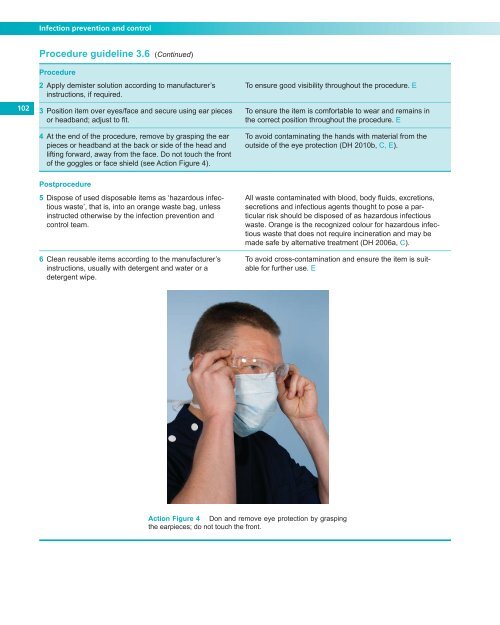Infection prevention and control - Royal Marsden Manual of Clinical ...
Infection prevention and control - Royal Marsden Manual of Clinical ...
Infection prevention and control - Royal Marsden Manual of Clinical ...
You also want an ePaper? Increase the reach of your titles
YUMPU automatically turns print PDFs into web optimized ePapers that Google loves.
102<br />
<strong>Infection</strong> <strong>prevention</strong> <strong>and</strong> <strong>control</strong><br />
Procedure guideline 3.6 (Continued)<br />
Procedure<br />
2 Apply demister solution according to manufacturer’s<br />
instructions, if required.<br />
3 Position item over eyes/face <strong>and</strong> secure using ear pieces<br />
or headb<strong>and</strong>; adjust to fi t.<br />
4 At the end <strong>of</strong> the procedure, remove by grasping the ear<br />
pieces or headb<strong>and</strong> at the back or side <strong>of</strong> the head <strong>and</strong><br />
lifting forward, away from the face. Do not touch the front<br />
<strong>of</strong> the goggles or face shield (see Action Figure 4 ).<br />
Postprocedure<br />
5 Dispose <strong>of</strong> used disposable items as ‘hazardous infectious<br />
waste’, that is, into an orange waste bag, unless<br />
instructed otherwise by the infection <strong>prevention</strong> <strong>and</strong><br />
<strong>control</strong> team.<br />
6 Clean reusable items according to the manufacturer’s<br />
instructions, usually with detergent <strong>and</strong> water or a<br />
detergent wipe.<br />
To ensure good visibility throughout the procedure. E<br />
To ensure the item is comfortable to wear <strong>and</strong> remains in<br />
the correct position throughout the procedure. E<br />
To avoid contaminating the h<strong>and</strong>s with material from the<br />
outside <strong>of</strong> the eye protection ( DH 2010b , C , E ).<br />
All waste contaminated with blood, body fl uids, excretions,<br />
secretions <strong>and</strong> infectious agents thought to pose a particular<br />
risk should be disposed <strong>of</strong> as hazardous infectious<br />
waste. Orange is the recognized colour for hazardous infectious<br />
waste that does not require incineration <strong>and</strong> may be<br />
made safe by alternative treatment ( DH 2006a , C ).<br />
To avoid cross-contamination <strong>and</strong> ensure the item is suitable<br />
for further use. E<br />
Action Figure 4 Don <strong>and</strong> remove eye protection by grasping<br />
the earpieces; do not touch the front.


